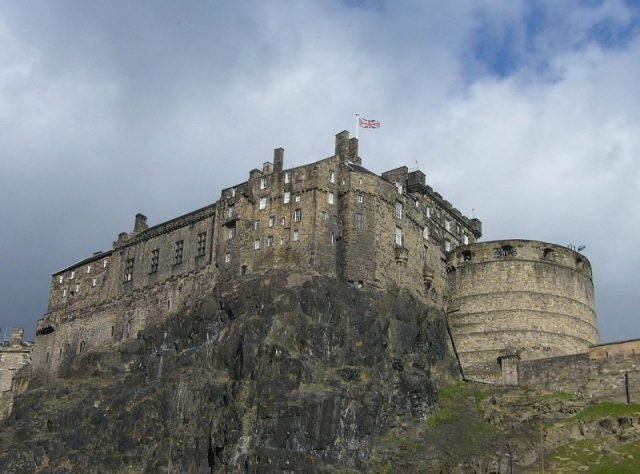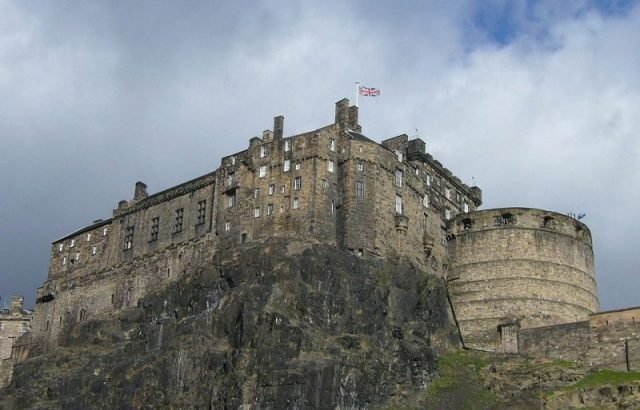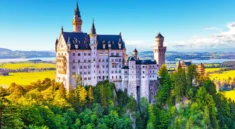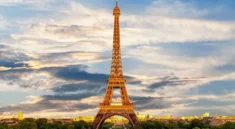
Nestled between green hills and the rugged North Sea coast, Edinburgh, the capital of Scotland, is a city that masterfully blends the grandeur of centuries past with the creative pulse of the present. It is a place where medieval castles dominate the skyline, cobbled streets echo with tales of monarchs and rebels, and every summer the city transforms into the beating heart of the world’s largest arts festival—the Edinburgh Festival Fringe.
Whether you are a history buff, a lover of the arts, or a curious traveler, Edinburgh offers a rare combination of cultural depth, architectural majesty, and vibrant contemporary expression. With its imposing fortress, historic Old and New Towns, and an electric festival atmosphere, Edinburgh isn’t just a city—it’s an experience.
Let’s explore what makes Edinburgh a unique destination where the past and present coexist in poetic harmony.
Edinburgh Castle: The Crown Jewel of Scottish History
Perched atop an ancient volcanic rock known as Castle Rock, Edinburgh Castle is arguably Scotland’s most iconic structure. Visible from almost anywhere in the city, it has stood as a symbol of strength and sovereignty for over 900 years.
A Fortress Through the Ages
The castle has played a central role in Scottish history. It has been a royal residence, a military stronghold, and the site of numerous sieges and battles, especially during the Wars of Scottish Independence. It has witnessed everything from coronations to imprisonments, and its stone walls have absorbed the echoes of kings, queens, and soldiers.
Inside, you can explore:
- The Crown Jewels of Scotland (also known as the Honours of Scotland)
- The Stone of Destiny, used in royal coronations
- The Great Hall, with its imposing hammerbeam roof and medieval weapons display
- St. Margaret’s Chapel, the oldest surviving building in Edinburgh
- The One O’Clock Gun, which fires daily and has become a beloved tradition
Walking through the castle is not just sightseeing—it’s stepping into the heart of Scottish national identity.
The Royal Mile: A Journey Through Time
Stretching from Edinburgh Castle at the top of Castle Rock to the grand Palace of Holyroodhouse at its foot, the Royal Mile is Edinburgh’s most famous street. It’s lined with centuries-old buildings, quaint closes (narrow alleys), and landmarks that whisper tales of royalty, religion, and rebellion.
Landmarks Along the Mile
- St Giles’ Cathedral: With its majestic crown-shaped spire, this 12th-century church has been central to Scotland’s religious and political life.
- The Real Mary King’s Close: A subterranean attraction that lets visitors explore preserved alleyways buried beneath the city, offering an eerie glimpse into life in the 1600s.
- Canongate Kirk and Tolbooth: Historical religious and civic buildings rich in heritage.
- Scottish Parliament: A striking contrast to the historic surroundings, the Parliament building is an example of bold modern architecture in the heart of Old Town.
With bagpipers playing traditional melodies and costumed guides recounting ghostly legends, the Royal Mile is a walk through time, where every stone has a story.
Old Town and New Town: A Tale of Two Cities
Edinburgh is famously built upon two contrasting but equally captivating areas: the Old Town and the New Town. Together, they form a UNESCO World Heritage Site, showcasing the city’s architectural evolution.
Old Town
The Old Town is a maze of narrow lanes, hidden courtyards, and dramatic medieval architecture. Its organic layout reflects the city’s ancient roots, and it remains largely untouched by modern grid planning. It’s home to:
- Writer’s Museum
- Grassmarket (a historic market square once used for public executions)
- Greyfriars Kirkyard, the cemetery that inspired parts of J.K. Rowling’s Harry Potter
New Town
Built in the 18th century during the Scottish Enlightenment, the New Town is a masterpiece of Georgian design, characterized by wide boulevards, symmetrical layouts, and neoclassical elegance. Its highlights include:
- Princes Street, a major shopping avenue
- Charlotte Square, home to the official residence of the First Minister
- The Scott Monument, a gothic spire dedicated to Sir Walter Scott, towering over Princes Street Gardens
Together, Old and New Town reflect the duality of Edinburgh—a city steeped in history yet always looking forward.
The Edinburgh Festival Fringe: The World’s Largest Arts Festival
Every August, Edinburgh sheds its somewhat reserved demeanor and becomes the most vibrant, diverse, and electrifying city on the planet. The Edinburgh Festival Fringe, often simply called the Fringe, is a month-long celebration of creativity without limits.
A Festival Like No Other
Founded in 1947 as an alternative to the more traditional Edinburgh International Festival, the Fringe has grown into a global phenomenon, hosting:
- Over 3,000 shows
- In 300+ venues
- Spanning genres like theatre, comedy, music, dance, spoken word, circus, and more
It’s a place where world-famous comedians perform alongside unknown artists. Where a street corner becomes a stage and an underground bar transforms into a Shakespearean theatre. There are no judges, no curators—just pure, unfiltered expression.
The Spirit of the Fringe
The Fringe is more than a festival; it’s a movement. It celebrates freedom of speech, diversity, and risk-taking. You might laugh uncontrollably at a stand-up show in a basement one hour, then cry at a solo drama about war the next.
Major performers like Eddie Izzard, Phoebe Waller-Bridge, and Rowan Atkinson began their careers here. But the real stars of the Fringe are often the unknown performers who come with little more than a dream and a backpack.
Other Festivals That Light Up the City
Edinburgh is often called the world’s leading festival city, and the Fringe is just one piece of that puzzle.
Edinburgh International Festival
Running concurrently with the Fringe, this festival focuses on classical performing arts—opera, ballet, music, and theatre—and is curated by a selection committee, offering a more formal contrast to the Fringe’s free-for-all spirit.
Edinburgh International Book Festival
Held in Charlotte Square, this is the largest public celebration of books and literature in the world, attracting top authors, thinkers, and political figures.
Hogmanay
Edinburgh’s New Year’s celebration is legendary, with torchlight processions, concerts, and street parties culminating in a spectacular fireworks display over the castle.
Green Spaces and Hilltop Views
Despite its medieval appearance and urban sophistication, Edinburgh is a city deeply connected to nature.
Arthur’s Seat
Located in Holyrood Park, Arthur’s Seat is an extinct volcano that offers panoramic views of the city. The hike to the top is moderately challenging but deeply rewarding, especially at sunrise or sunset.
Calton Hill
Closer to the city center, Calton Hill features several monuments, including the National Monument of Scotland, modeled after the Parthenon. It’s a favorite spot for photography and reflection.
Princes Street Gardens
This verdant strip divides Old Town from New Town and provides a peaceful respite with views of the castle looming above.
A Hub for Learning and Literature
Edinburgh’s contribution to education and literature is immense. It’s home to the University of Edinburgh, one of the oldest in the English-speaking world, and was the birthplace of the Scottish Enlightenment.
The city has produced or inspired literary giants such as:
- Sir Walter Scott
- Robert Louis Stevenson
- Arthur Conan Doyle
- J.K. Rowling, who famously wrote the early Harry Potter books in cafés around the city
In 2004, Edinburgh was named the world’s first UNESCO City of Literature, a title it wears proudly with its many bookstores, libraries, and literary events.
Culinary Scene and Local Delights
Scottish cuisine has come a long way, and Edinburgh offers everything from traditional fare to Michelin-starred dining.
- Try haggis, Scotland’s national dish, served with neeps and tatties (turnips and potatoes).
- Enjoy afternoon tea in historic hotels like The Balmoral.
- Sample whisky at the Scotch Whisky Experience or numerous local bars.
The city is also increasingly known for its international cuisine and sustainable food scene, making it a delightful place for foodies.
Planning Your Visit
- Best time to visit: August for festivals, spring and fall for fewer crowds and beautiful weather
- Getting around: Edinburgh is walkable, but trams and buses are efficient
- Where to stay: From luxurious castle-like hotels to charming B&Bs and hostels in Old Town
- Dress code: Weather can change quickly, so layers and a good raincoat are key
Conclusion: A City Like No Other
Edinburgh is a city of contrasts—ancient yet modern, reserved yet expressive, structured yet wildly creative. Where else can you explore a thousand-year-old castle in the morning and watch experimental street theatre in the afternoon?
Its towering spires, winding alleys, and grand festivals make it a place that doesn’t just preserve history—it lives it, reinterprets it, and puts it on stage for the world to see.
So whether you’re strolling the Royal Mile, climbing Arthur’s Seat, laughing at a Fringe comedy show, or listening to a symphony echo through a Georgian concert hall, you’ll find that Edinburgh isn’t just a destination—it’s a journey through time and imagination.



